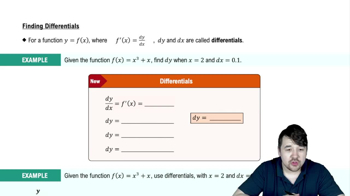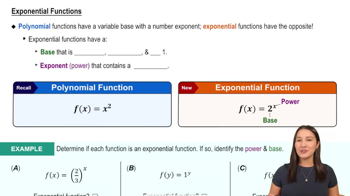Table of contents
- 0. Functions7h 52m
- Introduction to Functions16m
- Piecewise Functions10m
- Properties of Functions9m
- Common Functions1h 8m
- Transformations5m
- Combining Functions27m
- Exponent rules32m
- Exponential Functions28m
- Logarithmic Functions24m
- Properties of Logarithms34m
- Exponential & Logarithmic Equations35m
- Introduction to Trigonometric Functions38m
- Graphs of Trigonometric Functions44m
- Trigonometric Identities47m
- Inverse Trigonometric Functions48m
- 1. Limits and Continuity2h 2m
- 2. Intro to Derivatives1h 33m
- 3. Techniques of Differentiation3h 18m
- 4. Applications of Derivatives2h 38m
- 5. Graphical Applications of Derivatives6h 2m
- 6. Derivatives of Inverse, Exponential, & Logarithmic Functions2h 37m
- 7. Antiderivatives & Indefinite Integrals1h 26m
- 8. Definite Integrals4h 44m
- 9. Graphical Applications of Integrals2h 27m
- 10. Physics Applications of Integrals 3h 16m
- 11. Integrals of Inverse, Exponential, & Logarithmic Functions2h 34m
3. Techniques of Differentiation
The Chain Rule
Problem 3.R.13
Textbook Question
9–61. Evaluate and simplify y'.
y = e^2θ
 Verified step by step guidance
Verified step by step guidance1
Identify the given function: y = e^(2θ). We need to find the derivative y' with respect to θ.
Recognize that the function y = e^(2θ) is an exponential function where the exponent is a function of θ. This requires the use of the chain rule for differentiation.
Apply the chain rule: If y = e^(u) where u is a function of θ, then the derivative y' = e^(u) * (du/dθ). Here, u = 2θ.
Differentiate u = 2θ with respect to θ to find du/dθ. The derivative of 2θ with respect to θ is 2.
Substitute back into the chain rule formula: y' = e^(2θ) * 2. Simplify the expression to get the final form of the derivative.
 Verified video answer for a similar problem:
Verified video answer for a similar problem:This video solution was recommended by our tutors as helpful for the problem above
Video duration:
2mPlay a video:
Was this helpful?
Key Concepts
Here are the essential concepts you must grasp in order to answer the question correctly.
Differentiation
Differentiation is a fundamental concept in calculus that involves finding the derivative of a function. The derivative represents the rate of change of the function with respect to its variable. In this case, we need to differentiate the function y = e^(2θ) with respect to θ to find y'.
Recommended video:

Finding Differentials
Exponential Functions
Exponential functions are mathematical functions of the form f(x) = a * e^(bx), where e is the base of the natural logarithm. These functions exhibit rapid growth or decay and are characterized by their constant rate of change. Understanding the properties of exponential functions is crucial for differentiating them correctly.
Recommended video:

Exponential Functions
Chain Rule
The chain rule is a fundamental technique in calculus used to differentiate composite functions. It states that if a function y is composed of another function u, then the derivative of y with respect to x can be found by multiplying the derivative of y with respect to u by the derivative of u with respect to x. This rule is essential when differentiating functions like y = e^(2θ), where the exponent is itself a function of θ.
Recommended video:

Intro to the Chain Rule

 5:02m
5:02mWatch next
Master Intro to the Chain Rule with a bite sized video explanation from Patrick
Start learningRelated Videos
Related Practice






